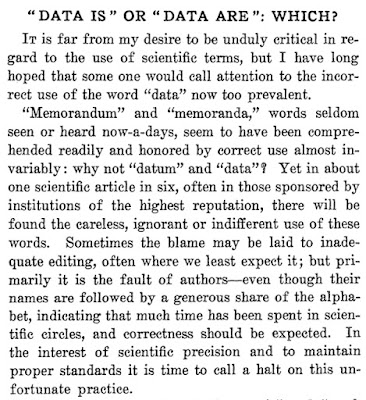The Amazon blurb:
A sweeping history of data anditstheir technical, political, and ethicalimpactimpacts on our world.
From facial recognition—capable of checking people into flights or identifying undocumented residents—to automated decision systems that inform who gets loans and who receives bail, each of us moves through a world determined by data-empowered algorithms. But these technologies didn’t just appear: they are part of a history that goes back centuries, from the census enshrined in the US Constitution to the birth of eugenics in Victorian Britain to the development of Google search.
Expanding on the popular course they created at Columbia University, Chris Wiggins and Matthew L. Jones illuminate the ways in which datahashave long been used asa tooltools anda weaponweapons in arguing for what is true, as well as a means of rearranging or defending power. They explore how datawaswere created and curated, as well as how new mathematical and computational techniques developed to contend withthatthose data serve to shape people, ideas, society, military operations, and economies. Although technology and mathematics are at its heart, the story of data ultimately concerns an unstable game among states, corporations, and people. How were new technical and scientific capabilities developed; who supported, advanced, or funded these capabilities or transitions; and how did they change who could do what, from what, and to whom?
Wiggins and Jones focus on these questions as they trace data’s historical arc, and look to the future. By understanding the trajectory of data—whereittheyhashave been and whereitthey might yet go—Wiggins and Jones argue that we can understand how to benditthem to ends that we collectively choose, with intentionality and purpose.
Yeah, I know. I've pretty much lost that "data are" fight. Just shows my age and pedantic irascibility. Perhaps this was just from an Amazon copywriter.
In the early 1990s, in the wake of more than 5 years as a programmer and SPC analyst in an Oak Ridge radioanalytical lab prior to moving to Las Vegas, I served a tenure as Technical Editor/Writer for a digital industrial diagnostics firm in West Knoxville, TN (portable FFT analyzers and related hardware and software products). I would routinely get tech paper drafts from the engineers and promptly change all the "data is" stuff to the proper "data are." My good-ole-boy redneck boss Forrest, our crew-cut mechanical engineer VP of marketing, would then red-pen my corrections back to "data is."
"It just looks wrong."
Yeah. Too bad.
I would quietly then change his edits right back, and my final cuts went off to production.
LOL: He once took issue with some of my own copy, and forbade me from henceforth using the words "affixed" and "atop"— e.g., "With the remote sensors firmly affixed atop the turbine housings..."
"They just look faggy."—Forrest.
Groan. Whatever. And, data ARE.
 |
| Letter to the editor, Science Magazine, April 8, 1927 |
Lordy.
Will let'cha know what I find in the book.
HOW DATA HAPPENED
Came onto this book via a Jill Lepore article in The New Yorker: "The Data Delusion."
…[I]imagine that all the world’s knowledge is stored, and organized, in a single vertical Steelcase filing cabinet. Maybe it’s lima-bean green. It’s got four drawers. Each drawer has one of those little paper-card labels, snug in a metal frame, just above the drawer pull. The drawers are labelled, from top to bottom, “Mysteries,” “Facts,” “Numbers,” and “Data.” Mysteries are things only God knows, like what happens when you’re dead. That’s why they’re in the top drawer, closest to Heaven. A long time ago, this drawer used to be crammed full of folders with names like “Why Stars Exist” and “When Life Begins,” but a few centuries ago, during the scientific revolution, a lot of those folders were moved into the next drawer down, “Facts,” which contains files about things humans can prove by way of observation, detection, and experiment. “Numbers,” second from the bottom, holds censuses, polls, tallies, national averages—the measurement of anything that can be counted, ever since the rise of statistics, around the end of the eighteenth century. Near the floor, the drawer marked “Data” holds knowledge that humans can’t know directly but must be extracted by a computer, or even by an artificial intelligence. It used to be empty, but it started filling up about a century ago, and now it’s so jammed full it’s hard to open.
From the outside, these four drawers look alike, but, inside, they follow different logics. The point of collecting mysteries is salvation; you learn about them by way of revelation; they’re associated with mystification and theocracy; and the discipline people use to study them is theology. The point of collecting facts is to find the truth; you learn about them by way of discernment; they’re associated with secularization and liberalism; and the disciplines you use to study them are law, the humanities, and the natural sciences. The point of collecting numbers in the form of statistics—etymologically, numbers gathered by the state—is the power of public governance; you learn about them by measurement; historically, they’re associated with the rise of the administrative state; and the disciplines you use to study them are the social sciences. The point of feeding data into computers is prediction, which is accomplished by way of pattern detection. The age of data is associated with late capitalism, authoritarianism, techno-utopianism, and a discipline known as data science, which has lately been the top of the top hat, the spit shine on the buckled shoe, the whir of the whizziest Tesla…
Read all of it.
BTW: "You are smarter than your data." Selected prior KHIT blog riffs.
Stay tuned...
__________

No comments:
Post a Comment